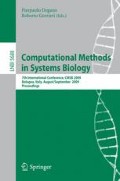Abstract
To cope with the increasing complexity of regulatory networks, we define a reduction method for multi-valued logical models.
Starting with a detailed model, this method enables the computation of a reduced model by iteratively “hiding” regulatory components. To keep a consistent behaviour, the logical rules associated with the targets of each hidden node are actualised to account for the (indirect) effects of its regulators.
The construction of reduced models ensures the preservation of a number of dynamical properties of the original model. In particular, stable states and more complex attractors are conserved. More generally, we focus on the relationship between the attractor configuration of the original model and that of the reduced model, along with the issue of attractor reachability.
The power of the reduction method is illustrated by its application to a multi-valued model of the segment-polarity network Controlling segmentation in the fly Drosophila melanogaster.
Access this chapter
Tax calculation will be finalised at checkout
Purchases are for personal use only
Preview
Unable to display preview. Download preview PDF.
References
Saez-Rodriguez, J., Simeoni, L., Lindquist, J., Hemenway, R., Bommhardt, U., Arndt, B., Haus, U., Weismantel, R., Gilles, E., Klamt, S., Schraven, B.: A logical model provides insights into t cell receptor signaling. PLoS Comput. Biol. 3(8), e163 (2007)
Franke, R., Müller, M., Wundrack, N., Gilles, E.D., Klamt, S., Kähne, T., Naumann, M.: Host-pathogen systems biology: logical modelling of hepatocyte growth factor and helicobacter pylori induced c-met signal transduction. BMC Syst. Biol. 2, 4 (2008)
Chaouiya, C., Remy, E., Mossé, B., Thieffry, D.: Qualitative analysis of regulatory graphs: a computational tool based on a discrete formal framework. LNCIS, vol. 294, pp. 119–126 (2003)
Naldi, A., Berenguier, D., Fauré, A., Lopez, F., Thieffry, D., Chaouiya, C.: Logical modelling of regulatory networks with GINsim 2.3. BioSystems (in press)
Thomas, R.: Regulatory networks seen as asynchronous automata: A logical description. J. Theor. Biol. 153, 1–23 (1991)
Thomas, R., Thieffry, D., Kaufman, M.: Dynamical behaviour of biological regulatory networks–i. biological role of feedback loops and practical use of the concept of the loop-characteristic state. Bull. Math. Biol. 57(2), 247–276 (1995)
Bryant, R.E.: Graph-based algorithms for boolean function manipulation. IEEE Trans. Comput. 35, 677–691 (1986)
Kam, T., Villa, T., Brayton, R.K., Sangiovanni-Vincentelli, A.L.: Multi-valued decision diagrams: Theory and applications. Int. J. Multi. Logic 4, 9–12 (1998)
Naldi, A., Thieffry, D., Chaouiya, C.: Decision diagrams for the representation and analysis of logical models of genetic networks. In: Calder, M., Gilmore, S. (eds.) CMSB 2007. LNCS (LNBI), vol. 4695, pp. 233–247. Springer, Heidelberg (2007)
Meinhardt, H.: Hierarchical inductions of cell states: a model for segmentation in drosophila. J. Cell Sci. Suppl. 4, 357–381 (1986)
von Dassow, G., Meir, E., Munro, E.M., Odell, G.M.: The segment polarity network is a robust developmental module. Nature 406(6792), 188–192 (2000)
Ingolia, N.T.: Topology and robustness in the drosophila segment polarity network. PLoS Biol. 2(6), e123 (2004)
Albert, R., Othmer, H.G.: The topology of the regulatory interactions predicts the expression pattern of the segment polarity genes in drosophila melanogaster. J. Theor. Biol. 223(1), 1–18 (2003)
Chaves, M., Albert, R., Sontag, E.D.: Robustness and fragility of boolean models for genetic regulatory networks. J. Theor. Biol. 235(3), 431–449 (2005)
Sánchez, L., Chaouiya, C., Thieffry, D.: Segmenting the fly embryo: logical analysis of the role of the segment polarity cross-regulatory module. Int. J. Dev. Biol. 52(8), 1059–1075 (2008)
González, A., Chaouiya, C., Thieffry, D.: Logical modelling of the role of the hh pathway in the patterning of the drosophila wing disc. Bioinformatics 24(16), i234–i240 (2008)
Sánchez, L., Thieffry, D.: Segmenting the fly embryo: a logical analysis of the pair-rule cross-regulatory module. J. Theor. Biol. 224(4), 517–537 (2003)
Fauré, A., Naldi, A., Chaouiya, C., Thieffry, D.: Dynamical analysis of a generic boolean model for the control of the mammalian cell cycle. Bioinformatics 22(14), e124–e131 (2006)
Remy, E., Ruet, P.: From minimal signed circuits to the dynamics of boolean regulatory networks. Bioinformatics 24(16), i220–i226 (2008)
Garg, A., Di Cara, A., Xenarios, I., Mendoza, L., De Micheli, G.: Synchronous versus asynchronous modeling of gene regulatory networks. Bioinformatics 24(17), 1917–1925 (2008)
Monteiro, P.T., Ropers, D., Mateescu, R., Freitas, A.T., de Jong, H.: Temporal logic patterns for querying dynamic models of cellular interaction networks. Bioinformatics 24(16), i227–i233 (2008)
Author information
Authors and Affiliations
Editor information
Editors and Affiliations
Rights and permissions
Copyright information
© 2009 Springer-Verlag Berlin Heidelberg
About this paper
Cite this paper
Naldi, A., Remy, E., Thieffry, D., Chaouiya, C. (2009). A Reduction of Logical Regulatory Graphs Preserving Essential Dynamical Properties. In: Degano, P., Gorrieri, R. (eds) Computational Methods in Systems Biology. CMSB 2009. Lecture Notes in Computer Science(), vol 5688. Springer, Berlin, Heidelberg. https://doi.org/10.1007/978-3-642-03845-7_18
Download citation
DOI: https://doi.org/10.1007/978-3-642-03845-7_18
Publisher Name: Springer, Berlin, Heidelberg
Print ISBN: 978-3-642-03844-0
Online ISBN: 978-3-642-03845-7
eBook Packages: Computer ScienceComputer Science (R0)

